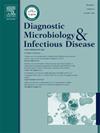在治疗成人复杂性尿路感染时,PCR 与传统培养和药敏试验的临床实用性比较:第二部分:诊断一致性、不一致结果和抗菌药物选择效果评估。
IF 2.1
4区 医学
Q3 INFECTIOUS DISEASES
Diagnostic microbiology and infectious disease
Pub Date : 2024-12-07
DOI:10.1016/j.diagmicrobio.2024.116646
引用次数: 0
摘要
目的:复杂性尿路感染(cUTIs)由于其多微生物的特性和对标准治疗的耐药性而难以控制。在目前的临床实践中,在获得培养和敏感性(C&S)结果之前,对cUTI的管理通常从广谱抗菌药物开始,但这些诊断延误进一步阻碍了治疗效果。聚合酶链反应(PCR)提供了一个更快的选择。本研究评估了PCR与C&S相比的效用,重点关注一致性、不一致结果、临床结果和抗菌药物选择效果,以改善cui管理。材料与方法:临床研究分为两部分,主要研究对象为cUTIs患者,亚研究对象为无尿路感染(UTI)体征或症状的健康个体。所有收集的样品均采用PCR和C&S分析进行比较。在第一部分研究的基础上,本研究评估了与不一致分析相关的结果测量。结果:总的来说,我们的研究支持PCR和C&S在阳性病例中的一致性(基线时为95.32%,研究结束时为88.06%),但在阴性病例中显示出一些不一致(基线时为62.91%,EOS时为38.30%)。健康人群亚研究的负一致性(NPA)为70.16%。对不一致结果的进一步分析显示,与c&s阳性感染治疗的患者相比,接受pcr阳性感染治疗的有症状患者有更好的临床结果(77.45%对71.42%)和更高的微生物根除率(53.92%对50%)。对抗菌药物使用和微生物学方面的进一步分析显示,PCR组更多地接受口服药物为主的治疗,而C&S组则接受其他形式的治疗(肌肉或膀胱冲洗)。在结果不一致的病例中,pcr阳性但培养阴性的病例多于pcr阴性但培养阳性的病例。结论:我们的临床应用研究数据表明,pcr引导的cUTIs管理总体上优于传统的C&S,具有几个优势。聚合酶链反应有可能通过早期采用窄范围抗生素治疗、改善临床结果和确保有效选择抗菌素来加强患者护理。pcr引导的管理计划可能特别有利于管理cUTIs患者,解决目前c&s引导的治疗方案偶尔忽略的感染。本文章由计算机程序翻译,如有差异,请以英文原文为准。
Clinical utility of PCR compared to conventional culture and sensitivity testing for management of complicated urinary tract infections in adults: Part II.Evaluation of diagnostic concordance, discordant results, and antimicrobial selection efficacy
Purpose
Complicated urinary tract infections (cUTIs) are difficult to manage due to their polymicrobial nature and resistance to standard therapies. In current clinical practice, the management of a cUTI often starts with broad-spectrum antimicrobials until culture and sensitivity (C&S) results are available, but these diagnostic delays further hinder treatment efficacy. Polymerase Chain Reaction (PCR) offers a faster alternative. This study evaluates PCR's utility compared to C&S, focusing on agreeability, discordant results, clinical outcomes, and antimicrobial selection efficacy to improve cUTI management.
Materials and Methods
The clinical study was conducted in two parts: the primary study focused on patients with cUTIs, while the sub-study involved healthy individuals without signs or symptoms of urinary tract infection (UTI). All collected samples underwent analysis using both PCR and C&S for comparison. Building on the first part of the study, the research evaluated outcome measures related to discordant analysis.
Results
Overall, our study supports good agreement between PCR and C&S in positive cases (95.32 % at baseline and 88.06 % at end of study (EOS)) but reveals some discordance in negative cases (38.30 % at baseline and 62.91 % at EOS). The negative percent agreement (NPA) in the sub-study on the healthy population was 70.16 %. Further analysis of discordant results revealed that symptomatic patients treated for PCR-positive infections trended toward better clinical outcomes (77.45 % vs. 71.42 %) and higher rates of microbiological eradication (53.92 % vs. 50 %) compared to those treated for C&S-positive infections. Additional analysis on antimicrobial use and microbiological aspects revealed that the PCR group received more oral medication-based treatments, while the C&S group received other forms (intramuscular or bladder irrigation). In cases of discordant results, there were more PCR-positive but culture-negative cases than PCR-negative but culture-positive cases.
Conclusions
Our clinical utility study data suggests that PCR-guided management of cUTIs is overall superior to conventional C&S, offering several advantages. PCR has the potential to enhance patient care by enabling the early adoption of narrower antibiotic therapies, improving clinical outcomes, and ensuring the effective selection of antimicrobials. A PCR-guided management plan could be particularly beneficial in managing patients with cUTIs, addressing infections that are occasionally overlooked with current C&S-guided treatment protocols.
求助全文
通过发布文献求助,成功后即可免费获取论文全文。
去求助
来源期刊
CiteScore
5.30
自引率
3.40%
发文量
149
审稿时长
56 days
期刊介绍:
Diagnostic Microbiology and Infectious Disease keeps you informed of the latest developments in clinical microbiology and the diagnosis and treatment of infectious diseases. Packed with rigorously peer-reviewed articles and studies in bacteriology, immunology, immunoserology, infectious diseases, mycology, parasitology, and virology, the journal examines new procedures, unusual cases, controversial issues, and important new literature. Diagnostic Microbiology and Infectious Disease distinguished independent editorial board, consisting of experts from many medical specialties, ensures you extensive and authoritative coverage.

 求助内容:
求助内容: 应助结果提醒方式:
应助结果提醒方式:


